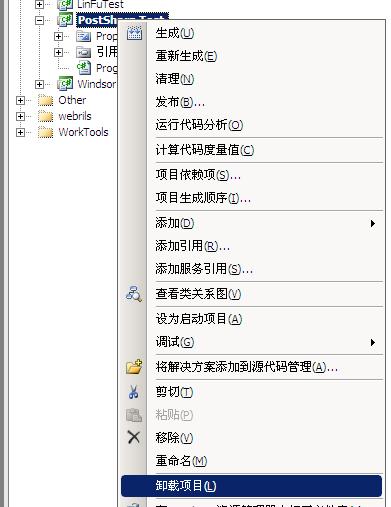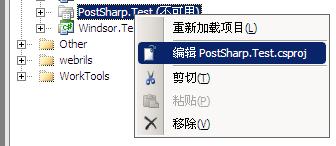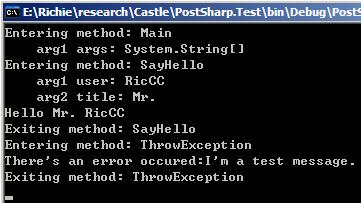PostSharp是一个非常优秀的AOP框架,使用上非常方便,功能强大,对目标拦截的方法不需要做什么修改,但现在已经商业化运作
从PostSharp官方网站下载一个试用版,安装
简单示例
PostSharp采用Post-Compile的方式实现AOP,即对已经生成的程序集,按照拦截规则进行修改,对需要拦截的方法注入拦截代码。这种方式与基于动态代理的方式相比,没有过多限制,比如不需要目标方法为virtual类型或者实现了接口等
1. 新建一个PostSharp.Test的Console测试项目添加引用: PostSharp、PostSharp.Laos
2. 程序引用的命名空间
using System;
using System.Reflection;
using PostSharp.Laos;
3. 测试用的代码如下:
|
1
2
3
4
5
6
7
8
9
10
11
12
13
14
15
16
17
18
19
20
21
|
private static void SayHello(string user, string title) { Console.WriteLine(string.Format("Hello {0} {1}", title, user)); } private static void ThrowException() { throw new Exception("I'm a test message."); } static void Main(string[] args) { SayHello("Richie", "Mr."); try { ThrowException(); } catch { } Console.ReadKey(); return; } |
4. 然后在项目中实现一个aspect:
|
1
2
3
4
5
6
7
8
9
10
11
12
13
14
15
16
17
18
19
20
21
22
23
|
[Serializable] public class OnMyExceptionAspect : OnMethodBoundaryAspect { public override void OnEntry(MethodExecutionEventArgs eventArgs) { base.OnEntry(eventArgs); Console.WriteLine(string.Format("Entering method: {0}", eventArgs.Method.Name)); object[] arguments = eventArgs.GetReadOnlyArgumentArray(); ParameterInfo[] parameters = eventArgs.Method.GetParameters(); for (int i = 0; arguments != null && i < arguments.Length; i++) Console.WriteLine(string.Format(" arg{0} {1}: {2}", i + 1, parameters[i].Name, arguments[i])); } public override void OnExit(MethodExecutionEventArgs eventArgs) { base.OnExit(eventArgs); Console.WriteLine(string.Format("Exiting method: {0}", eventArgs.Method.Name)); } public override void OnException(MethodExecutionEventArgs eventArgs) { Console.WriteLine("There's an error occured:" + eventArgs.Exception.Message); base.OnException(eventArgs); } } |
我们使用这个aspect对测试代码进行拦截处理,输出方法调用的日志信息
5. 接下来的2个步骤就是设置项目,使得PostSharp在编译结束后能够对生成的程序集进行修改,假如拦截处理机制
a). 在项目中添加一个assembly指令,告诉PostSharp对哪些目标实施拦截
[assembly: PostSharp.Test.OnMyExceptionAspect(
AttributeTargetAssemblies = "PostSharp.Test",
AttributeTargetTypes = "PostSharp.Test.Program")]
b). 修改项目文件,让PostSharp在编译完成后能够注入拦截代码:
先通过VS的右键菜单卸载项目
然后通过VS邮件菜单编辑项目文件,添加一个import指令:
在<Import Project="$(MSBuildToolsPath)Microsoft.CSharp.targets" />后面添加一条import指令如下:
<Import Project="E:Program FilesPostSharp 2.0PostSharp.targets" />
6. 重新加载项目,编译,PostSharp就会在我们指定的位置上使用我们的OnMyExceptionAspect对Program的方法调用注入拦截代码,运行结果如下:
使用Attribute方式
上面使用一个assembly指令告诉PostSharp应该对哪些方法实施拦截,OnMethodBoundaryAspect类已经继承了Attribute,因此我们可以通过给类或者方法添加Attribute的方式来代替assembly指令
下面示例需要引用的命名空间:
我们用下面的PropertyChangedNotificationAttribute来实现对象属性更改通知:
|
1
2
3
4
5
6
7
8
9
10
11
12
13
14
15
16
17
18
19
20
21
22
23
24
25
26
27
28
29
30
31
32
33
34
35
36
|
[Serializable] [MulticastAttributeUsage(MulticastTargets.Method)] public class PropertyChangedNotificationAttribute : OnMethodBoundaryAspect { private object _preValue; public override void OnExit(MethodExecutionEventArgs eventArgs) { base.OnExit(eventArgs); if (!eventArgs.Method.IsSpecialName) return; if (!eventArgs.Method.Name.StartsWith("get_") && !eventArgs.Method.Name.StartsWith("set_")) return; bool isSetter = eventArgs.Method.Name.StartsWith("set_"); string property = eventArgs.Method.Name.Substring(4); if (isSetter) Console.WriteLine(string.Format("Property "{0}" was changed from "{1}" to "{2}"." , property , this._preValue , this.GetPropertyValue(eventArgs.Instance, property))); else Console.WriteLine(string.Format("Property "{0}" was read.", property)); } public override void OnEntry(MethodExecutionEventArgs eventArgs) { base.OnEntry(eventArgs); //记录属性更改前的值 if (!eventArgs.Method.IsSpecialName) return; if (!eventArgs.Method.Name.StartsWith("set_")) return; string property = eventArgs.Method.Name.Substring(4); this._preValue = this.GetPropertyValue(eventArgs.Instance, property); } private object GetPropertyValue(object instance, string property) { PropertyInfo getter = instance.GetType().GetProperty(property); return getter.GetValue(instance, null); } } |
然后给测试类添加PropertyChangedNotification的attribute就能通过AOP实现对象属性更改通知的效果:
|
1
2
3
4
5
6
7
8
9
10
11
12
13
14
15
16
17
18
19
20
21
22
23
24
25
26
27
28
29
30
31
32
33
|
[PropertyChangedNotification] public class Person { private string firstName; private string lastName; public Person(string first, string last) { this.firstName = first; this.lastName = last; } public string FirstName { get { return firstName; } set { firstName = value; } } public string LastName { get { return lastName; } set { lastName = value; } } public string Name { get { return this.FirstName + " " + this.LastName; } } } <BR> static void Main(string[] args) { Person user = new Person("Richie", "Liu"); user.FirstName = "RicCC"; Console.WriteLine(string.Format("{{ {0} {1} }}", user.FirstName, user.LastName)); Console.ReadKey(); } |
编译生成,运行结果如下:
因为我们在Property的setter方法进入(OnEntry)时用反射读取了属性的值,记录修改之前的属性值;然后在setter方法结束(OnExit)时又使用反射去读取了修改之后的属性值,因此在***was changed from *** to ***这条消息之前,有2条属性的读取日志
Cache示例
PostSharp中有个缓存方法调用的示例:第一次调用方法的时候,执行这个方法,并把执行结果缓存起来;后面再调用这个方法时,就直接从缓存中取结果,让方法返回,而不执行方法体
实现这一功能的aspect类如下:
|
1
2
3
4
5
6
7
8
9
10
11
12
13
14
15
16
17
18
19
20
21
22
23
24
25
26
27
28
29
30
31
32
33
34
35
36
37
38
39
40
41
42
43
44
45
46
47
48
49
50
51
52
53
54
55
56
57
58
59
60
61
62
63
64
65
66
67
68
69
70
71
72
73
74
75
76
77
|
[Serializable] public sealed class CacheAttribute : OnMethodBoundaryAspect { // 用来生成缓存的key值,key值中包含方法名、参数值等,因此参数不一时方法会被执行 private MethodFormatStrings formatStrings; // 用于缓存 private static readonly Dictionary<STRING, object=""> cache = new Dictionary<STRING, object="">(); <BR> // 编译时刻执行的方法 // Cache这个attribute用于方法上,某些方法不允许使用缓存,将在下面进行检查 public override bool CompileTimeValidate(MethodBase method) { // Don't apply to constructors. if (method is ConstructorInfo) { Message.Write(SeverityType.Error, "CX0001", "Cannot cache constructors."); return false; } MethodInfo methodInfo = (MethodInfo)method; // Don't apply to void methods. if (methodInfo.ReturnType.Name == "Void") { Message.Write(SeverityType.Error, "CX0002", "Cannot cache void methods."); return false; } // Does not support out parameters. ParameterInfo[] parameters = method.GetParameters(); for (int i = 0; i < parameters.Length; i++) { if (parameters[i].IsOut) { Message.Write(SeverityType.Error, "CX0003", "Cannot cache methods with return values."); return false; } } return true; } // 编译时刻执行的方法 public override void CompileTimeInitialize(MethodBase method, AspectInfo aspectInfo) { this.formatStrings = Formatter.GetMethodFormatStrings(method); } <BR> public override void OnEntry(MethodExecutionArgs eventArgs) { //生成缓存的key值 string key = this.formatStrings.Format( eventArgs.Instance, eventArgs.Method, eventArgs.Arguments.ToArray()); lock (cache) { object value; //查看是否存在缓存 if (!cache.TryGetValue(key, out value)) // 缓存不存在,继续执行这个方法,并将key存在MethodExecutionTag,在执行完毕的 // OnSuccess事件时使用key值将结果放到缓存中 eventArgs.MethodExecutionTag = key; else { // 已经在缓存中存在,则将执行的返回值直接设置为缓存中的值,不执行方法体而立即返回 eventArgs.ReturnValue = value; eventArgs.FlowBehavior = FlowBehavior.Return; } } } <BR> //这个事件只有在方法体被执行了,并且执行成功没有异常发生时才会触发 public override void OnSuccess(MethodExecutionArgs eventArgs) { // 取得缓存的key值 string key = (string)eventArgs.MethodExecutionTag; // 把执行结果放入缓存中 lock (cache) { cache[key] = eventArgs.ReturnValue; } } }</STRING,></STRING,> |
测试代码如下:
|
1
2
3
4
5
6
7
8
9
10
11
12
13
14
15
16
|
public static void Main( string[] args ) { Console.WriteLine( "1 ->" + GetDifficultResult( 1 ) ); Console.WriteLine( "2 ->" + GetDifficultResult( 2 ) ); Console.WriteLine( "1 ->" + GetDifficultResult( 1 ) ); Console.WriteLine( "2 ->" + GetDifficultResult( 2 ) ); Console.ReadKey(); } [Cache] private static int GetDifficultResult( int arg ) { // 如果方法体被执行了,则会输出下面的消息,否则不会输出,说明使用了缓存 Console.WriteLine( "Some difficult work!" ); Thread.Sleep( 1000 ); return arg; } |
参数为1和2的时候分别执行以下方法体,后面2次调用则都是从缓存中直接取返回值了
DbInvoke示例
这也是PostSharp中一个比较有意思的示例,其工作方式大致如下,先使用下面代码声明一些方法:
|
1
2
3
4
5
6
7
8
9
10
|
[DbInvoke("ConnectionString")] internal static class DataLayer { #pragma warning disable 626 extern static public void CreateCustomer(string customerName, out int customerId); extern static public void ModifyCustomer(int customerId, string customerName); extern static public void DeleteCustomer(int customerId); extern static public void ReadCustomer(int customerId, out string customerName); #pragma warning restore 626 } |
这里每个方法代表一个数据库的存储过程,通过DbInvoke这个attribute实施拦截(DbInvoke继承自PostSharp.Aspects.ImplementMethodAspect,PostSharp直接使用这个类的OnExecution方法代替对原方法的调用,他用于实现对extern方法、abstract类的方法提供拦截实现),然后将方法名作为存储过程名字,参数名字则作为存储过程参数名,将.NET数据类型转化为数据库的数据类型,执行存储过程,并处理out、ref类型的参数,将存储过程执行结果的参数值设置到方法的相关参数上
通过这样的方式,将数据库的存储过程声明为.NET中的extern方法,简化对存储过程的调用方式
Aspect的类型
1. OnMethodBoundaryAspect
可以override OnEntry、OnExit、OnSuccess、OnException等方法实施拦截,可以读取入参,修改ref、out类型的入参,决定是否调用被拦截的方法体,以及读取、修改方法的返回值等,一般可以用于自己编写的assembly,进行日志记录等操作
PostSharp对原方法注入一个try{}catch(){}语句,在适当的位置注入各个拦截事件的调用代码
当对同一个方法使用多个该类型的aspect时,可以通过设置或者实现AspectPriority来确定各个拦截器的执行顺序
类似于前面的Cache示例中使用到的,在aspect之间或者拦截的各个方法之间,可以通过MethodExecutionEventArgs的MethodExecutionTag属性来传递必要的状态信息
2. OnExceptionAspect
用于实现异常捕获,可以运用于第三方开发的,没有源代码的assembly上
3. OnFieldAccessAspect
方便对field的读取、设置进行拦截处理,override OnGetValue、OnSetValue方法实施拦截。测试过程中无法读取到FieldInfo属性,不知道是不是只有商业版注册后才可以使用这个功能
对field访问的拦截只能适用于当前程序集,如果其他程序集直接诶访问field无法实现拦截,所以对于public、protected类型的field,PostSharp会将field重命名,然后自动生成一个原field名字的property,这会导致依赖的程序集二进制兼容性被破坏,需要重新编译。这个行为也可以通过选项进行配置,阻止PostSharp这样做
4. OnMethodInvocationAspect
override OnInvocation方法实施拦截,PostSharp不是直接修改注入目标程序集,而是为目标方法生成一个委托,修改当前程序集中的调用,改为调用委托,从而实现拦截(这种方式叫做Call-site weaving,调用方织入,对应的另一种方式叫做Target-site weaving,目标织入)。这种方式可以实现对第三方程序集方法实施拦截
5. ImplementMethodAspect
如前面的DbInvoke示例,这个aspect用于extern方法、abstract类的方法进行拦截,不要求目标方法有具体的实现
Aspect的生命周期
aspect在编译期实例化,PostSharp将aspect的实例序列化存到assembly中,在运行时再反序列化回来
对multicast类型的attribute,PostSharp会为每个匹配到的类型、方法等单独创建一个该attribute的实例对象应用于目标上
multicast概念:本来我们写一个custom attribute,必须在每个需要运用的方法、类型上面使用这个attribute,PostSharp中的multicast指可以指定比较宽的一个范围,或者使用正则表达式以及一些filter等,将这个attribute应用到匹配到的多个目标对象上面去,类似于多播这样的效果。这就是在前面使用过的assembly指令
这个概念导致的一个结果,对于理解PostSharp的行为比较重要,如果某个multicast类型的attribute指定为作用于field,但又将这个attribute设置在了type上面,则PostSharp会为该type的所有field运用这个attribute,从而运用拦截处理
另外,PostSharp的示例AdvancedAssemblyExplorer项目演示了如何使用PostSharp的CodeModel。PostSharp没有使用Mono.Cecil和CCI等开源项目,而是建立了自己的CodeModel来分析和修改assembly的元数据以及IL代码等,通过这个示例可以大致了解如何使用PostSharp的CodeModel来实现某些元数据、IL层面的操作
参考:
Aspect Oriented Programming 101
AOP Implementation of INotifyPropertyChanged



